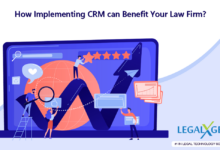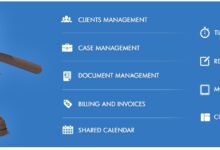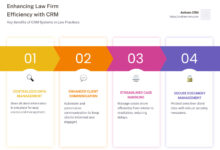CRM Legal Software: Streamlining Legal Practice
CRM legal software revolutionizes how legal professionals manage their practices. It moves beyond basic contact management, offering integrated solutions for case management, document storage, client communication, and reporting. This powerful technology streamlines workflows, enhances client relationships, and ultimately boosts firm efficiency and profitability.
This exploration delves into the core functionalities of CRM legal software, highlighting its key differences from general CRM systems. We’ll examine its applications across various legal specialties, explore integration capabilities, and address common challenges in implementation. Ultimately, we aim to provide a comprehensive understanding of how CRM legal software can transform legal practices.
Defining CRM Legal Software
CRM legal software represents a specialized category of Customer Relationship Management (CRM) systems designed to meet the unique needs of legal professionals and firms. Unlike general CRM systems, it incorporates features specifically tailored for managing client matters, legal documents, deadlines, and communication within the context of legal practice. This targeted functionality streamlines workflows and enhances efficiency across various aspects of legal operations.
Core Functionalities of CRM Legal Software
Legal CRM systems offer a robust suite of features beyond those found in standard CRM solutions. Central to their functionality is the ability to manage client matters comprehensively, including tracking case details, deadlines, communications, and associated documents. They typically integrate with other legal technologies, such as document management systems and e-discovery platforms, creating a unified ecosystem for managing legal work. Further functionalities often include time tracking for billing purposes, conflict-of-interest checking, and reporting tools for performance analysis. These features contribute to improved efficiency, better client service, and enhanced profitability for law firms.
Key Differences Between CRM Legal Software and General CRM Systems
While both types of systems manage relationships, the core differences lie in their specialization. General CRM systems are designed for broad application across various industries, focusing on sales, marketing, and customer service. Legal CRM software, however, is built with the specific requirements of legal practice in mind. This includes features like matter management, legal document handling, compliance features (e.g., data security, ethical considerations), and integration with legal-specific technologies. General CRMs lack the specialized tools and features necessary for efficient legal practice management, such as integrated conflict checks and sophisticated document management tailored to legal workflows. The core difference is the level of specialization and the integration with legal-specific processes and technologies.
Examples of Legal Professional Utilization of CRM Legal Software
Legal professionals leverage CRM legal software in various ways to improve their daily operations. For instance, a lawyer can use the system to track all aspects of a client’s case, from initial consultation notes to court filings and correspondence. This centralized system ensures nothing is overlooked and facilitates seamless collaboration among team members. Furthermore, the software aids in managing deadlines, sending automated reminders, and generating accurate client billing statements. Paralegals can use the system to organize and manage documents related to various cases, while administrative staff can utilize it for scheduling and client communication. The system’s reporting features provide valuable insights into firm performance and profitability, helping legal professionals make informed business decisions.
Comparison of Leading CRM Legal Software Solutions
| Feature | Pricing | Pros | Cons |
|---|---|---|---|
| Comprehensive matter management, document management, client portal, reporting, and integrations. | Variable, depending on the number of users and features. Typically subscription-based. | Centralized platform for managing all aspects of legal practice, improved efficiency and collaboration. | Can be expensive, requires training and implementation. |
| Strong matter management, time tracking, billing, and reporting capabilities. Good integrations with other legal tech. | Tiered pricing based on features and user count. Often includes a free trial. | User-friendly interface, robust reporting tools, strong customer support. | Limited customization options compared to some competitors. |
| Focuses on collaboration and communication, with features like task management, document sharing, and client communication tools. | Subscription-based, with pricing varying based on user numbers and features. | Excellent for team collaboration, intuitive interface, good value for smaller firms. | May lack some advanced features found in other solutions. |
Features of CRM Legal Software
A robust CRM (Customer Relationship Management) system tailored for legal practices offers a suite of features designed to streamline operations, enhance client communication, and improve overall efficiency. These features go beyond basic contact management, integrating specialized tools to address the unique demands of the legal profession.
Effective legal CRM software seamlessly blends contact management with crucial legal-specific functionalities, offering a centralized hub for all client-related information and tasks. This integration significantly reduces administrative burden and allows legal professionals to focus more on strategic work and client service.
Integrated Legal Document Management
Integrating legal document management directly within the CRM system provides numerous benefits. This integration eliminates the need for separate document storage and retrieval systems, creating a single source of truth for all case-related documents. This centralized approach simplifies document access, version control, and collaboration among team members. The system can also automate document routing and reminders, ensuring timely responses and adherence to deadlines. For example, a contract automatically triggers a reminder for review and signature at a specified date, reducing the risk of missed deadlines and improving overall efficiency.
Security and Compliance Features
Security and compliance are paramount in legal CRM software. The software must adhere to stringent data privacy regulations like GDPR and CCPA, ensuring the confidentiality and protection of sensitive client information. Features such as robust access controls, data encryption, and audit trails are essential. Furthermore, the system should facilitate compliance with ethical rules and regulations governing legal practice, including maintaining accurate records and preventing conflicts of interest. For instance, the software might incorporate features that automatically flag potential conflicts of interest based on client data and assigned personnel.
Client Case Management User Interface Mockup
Imagine a user interface displaying a client’s case file. The central area shows a summary of the case: client name, case type, status (e.g., “Open,” “In Progress,” “Closed”), and key dates (filing date, deadlines, etc.). To the left, a sidebar displays a chronological timeline of all activities related to the case, including emails, phone calls, documents uploaded, and tasks completed. To the right, a panel displays related documents organized by type (e.g., pleadings, discovery, contracts). Each document displays its title, date uploaded, and a thumbnail preview. Users can easily filter and search through documents, access them with a single click, and update the case status directly from this view. Below the main area, a section shows associated tasks, with options to mark tasks as complete, reschedule, or assign them to team members. This design prioritizes clear visual organization and easy access to critical information, reducing time spent searching for data and improving overall workflow efficiency.
Benefits and Applications of CRM Legal Software
Implementing a CRM system offers significant advantages for law firms of all sizes, streamlining operations, improving client relationships, and ultimately boosting profitability. By centralizing client information, managing cases effectively, and automating tasks, legal CRMs contribute to a more efficient and client-focused practice.
The benefits extend beyond simple organization. Legal CRM software empowers firms to leverage data for strategic decision-making, improve client communication, and enhance overall operational efficiency, leading to increased revenue and reduced administrative overhead. This translates to a more sustainable and successful legal practice in today’s competitive landscape.
Case Studies Demonstrating Positive Impact on Law Firm Efficiency
Several law firms have reported significant improvements in efficiency after adopting CRM legal software. For example, a mid-sized personal injury firm saw a 25% reduction in administrative time spent on client communication and case file management after implementing a CRM system with automated email and task assignment features. Another example is a corporate law firm that experienced a 15% increase in billable hours due to improved case tracking and better allocation of attorney time, facilitated by the CRM’s detailed case management capabilities. These improvements highlight the tangible impact of CRM software on reducing operational costs and maximizing resource utilization.
Return on Investment (ROI) Compared to Traditional Methods
While the initial investment in CRM legal software requires upfront costs, the long-term ROI often surpasses traditional methods of case management. Traditional methods, relying heavily on manual processes and disparate systems, lead to inefficiencies such as lost paperwork, duplicated efforts, and missed deadlines. These inefficiencies translate into lost revenue and increased operational expenses. A CRM system, on the other hand, automates many of these tasks, reducing errors and improving the overall efficiency of the firm. The cost savings from reduced administrative overhead, improved client retention, and increased billable hours often outweigh the initial investment within a year or two, resulting in a substantial ROI. This return is particularly noticeable in larger firms with a high volume of cases.
Legal Specialties Benefiting Most from CRM Legal Software
Various legal specialties can benefit significantly from CRM software.
- Personal Injury Law: Managing numerous cases simultaneously, tracking medical records, and communicating with clients and insurance companies efficiently are crucial. A CRM streamlines these processes.
- Family Law: The sensitive nature of family law requires meticulous record-keeping and clear communication. CRM software ensures that all relevant information is readily accessible and securely stored.
- Corporate Law: Managing complex transactions and maintaining detailed client records are vital. CRM software assists in tracking deadlines, managing documents, and ensuring compliance.
- Real Estate Law: CRM systems can help manage multiple property transactions, track deadlines, and facilitate communication with clients, buyers, and sellers.
- Criminal Defense Law: Efficient case management, secure document storage, and timely communication with clients are critical in criminal defense. CRM systems can enhance these aspects significantly.
Improving Client Communication and Relationship Management
CRM software enhances client communication and relationship management through several key features. Automated email reminders for appointments and deadlines ensure clients are kept informed and engaged. Centralized client profiles provide a 360-degree view of each client’s history, preferences, and communication style, enabling personalized interactions. Secure portals allow clients to access their case files and communicate directly with their attorneys, fostering transparency and trust. These features contribute to improved client satisfaction and stronger client relationships, leading to increased client retention and referrals.
Integration and Customization
Effective legal CRM software goes beyond basic contact management; seamless integration with other legal tech tools and the ability to tailor the system to a firm’s unique workflow are crucial for maximizing its value. This section explores the importance of integration, customization options, reporting capabilities, and provides a practical guide to implementing a CRM system within a law firm.
API Integrations for Enhanced Functionality
API (Application Programming Interface) integrations allow legal CRM software to connect with other essential legal technology tools, streamlining workflows and reducing data silos. For example, integration with a document management system allows for easy access to relevant files directly within the CRM, eliminating the need to switch between applications. Similarly, integrating with e-signature platforms automates the process of obtaining client signatures on important documents. A well-integrated system reduces manual data entry, minimizing errors and saving valuable time. This interoperability boosts efficiency and enhances the overall user experience. The specific benefits depend on the integrated applications, but common improvements include faster document processing, reduced administrative overhead, and improved client communication.
Customizing CRM Legal Software to Meet Specific Firm Needs
Customizing a legal CRM system involves tailoring its features and functionalities to align perfectly with a law firm’s unique operational needs and preferences. This may involve configuring workflows, customizing fields to capture specific data points relevant to the firm’s practice areas, and adjusting user permissions to ensure data security and control. For instance, a firm specializing in intellectual property law might require custom fields to track patent applications, trademarks, and copyrights, while a family law firm might prioritize fields related to child custody arrangements and support payments. Many systems offer flexible configuration options through user-friendly interfaces, allowing administrators to modify settings without requiring extensive technical expertise. More complex customizations might necessitate the assistance of the software vendor or a specialized consultant.
Reporting and Analytics Capabilities
Robust reporting and analytics capabilities are vital for gaining insights into firm performance and identifying areas for improvement. Legal CRM software typically offers a range of pre-built reports on key metrics such as caseload, client acquisition costs, and attorney productivity. Furthermore, many systems allow users to create custom reports to track specific data points relevant to their needs. Data visualization tools, such as charts and graphs, help to present complex data in a clear and easily understandable format. This information is invaluable for strategic decision-making, resource allocation, and demonstrating the return on investment (ROI) of the CRM system. For example, analyzing case closure rates by attorney can identify areas needing additional training or support, while tracking client acquisition costs can inform marketing strategies.
Implementing a CRM Legal Software System: A Step-by-Step Guide
Implementing a new CRM system requires careful planning and execution. A phased approach ensures a smoother transition and minimizes disruption to daily operations.
- Needs Assessment and Selection: Identify the firm’s specific needs and requirements, research available CRM solutions, and select a system that aligns with those needs and budget.
- Data Migration: Plan and execute the migration of existing client and case data into the new CRM system. This may involve data cleansing and formatting to ensure data accuracy and consistency.
- System Configuration and Customization: Configure the CRM system to meet the firm’s specific requirements, including customizing fields, workflows, and user permissions.
- User Training: Provide comprehensive training to all users on how to effectively utilize the CRM system. This should include hands-on sessions and ongoing support.
- Go-Live and Monitoring: Launch the CRM system and closely monitor its performance. Address any issues that arise and make necessary adjustments.
- Ongoing Optimization: Continuously evaluate the effectiveness of the CRM system and make adjustments as needed to optimize its performance and ensure it continues to meet the firm’s evolving needs.
Challenges and Considerations
Implementing CRM legal software, while offering significant benefits, presents several challenges that legal firms must carefully consider. Successful adoption requires a strategic approach that addresses potential obstacles and leverages best practices to maximize return on investment. This section explores key challenges and provides guidance on mitigating risks.
Data Migration and System Integration
Migrating existing data from legacy systems to a new CRM legal software solution can be complex and time-consuming. Thorough planning is crucial, involving data cleansing, validation, and transformation to ensure data integrity and compatibility with the new system. This process often requires specialized expertise and may involve significant upfront investment. Successful integration with existing applications, such as case management systems or accounting software, is also essential for seamless workflow and data consistency. Best practices include developing a detailed migration plan, conducting thorough testing, and implementing a phased rollout approach to minimize disruption. For example, a law firm might prioritize migrating client data first, followed by case information and finally, document management systems. This phased approach allows for incremental testing and validation, reducing the risk of errors and data loss.
Data Security and Privacy
Legal firms handle highly sensitive client data, making data security and privacy paramount. Choosing a CRM legal software solution that adheres to stringent security standards and complies with relevant regulations, such as GDPR and CCPA, is essential. This includes robust access controls, encryption, and regular security audits. Furthermore, firms must establish clear data security policies and procedures, including employee training on data handling best practices. For instance, implementing multi-factor authentication and regularly updating software patches are crucial steps to enhance security. Data breaches can have severe financial and reputational consequences for legal firms, highlighting the importance of proactive security measures.
Cost Considerations
The cost of implementing and maintaining CRM legal software varies significantly depending on factors such as the size of the firm, the chosen software solution, and the level of customization required. Costs include the initial software license fee, implementation costs (consulting, training, data migration), ongoing maintenance fees, and potential integration costs with other systems. For example, a smaller firm might opt for a cloud-based solution with a lower upfront cost, while a larger firm might invest in an on-premise solution with greater customization options but higher initial investment. A thorough cost-benefit analysis is crucial before making a decision, considering both short-term and long-term expenses. It’s important to factor in potential cost savings from improved efficiency and reduced administrative overhead. This analysis should clearly outline all associated costs and the expected return on investment (ROI) over a specific timeframe.
Final Wrap-Up
Implementing CRM legal software represents a significant investment, but the potential return on investment is substantial. From improved client relationships and streamlined workflows to enhanced data security and insightful reporting, the benefits far outweigh the challenges. By carefully considering the specific needs of your firm and selecting a solution that aligns with your goals, you can unlock the full potential of this transformative technology and achieve greater efficiency and success in your legal practice.


